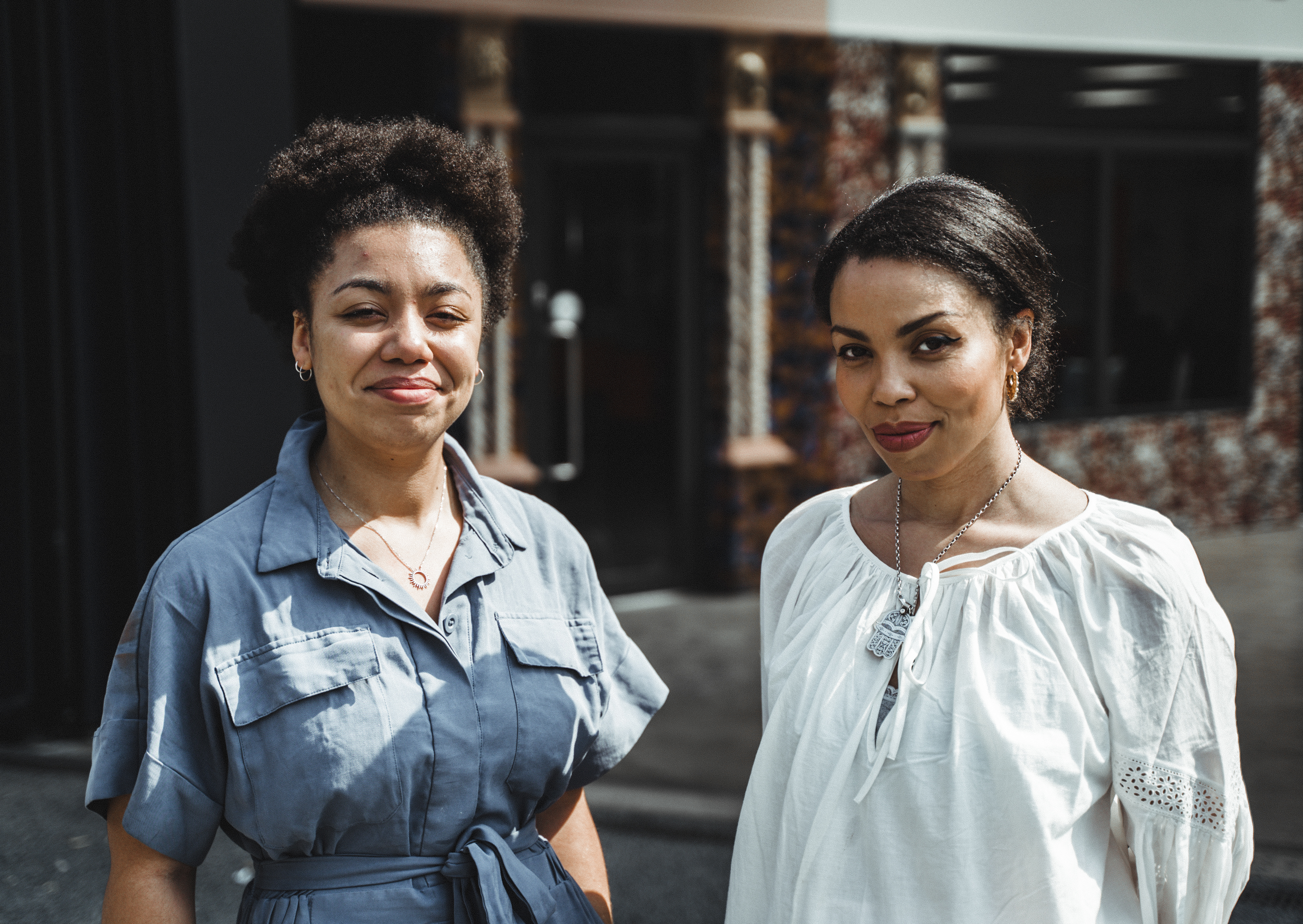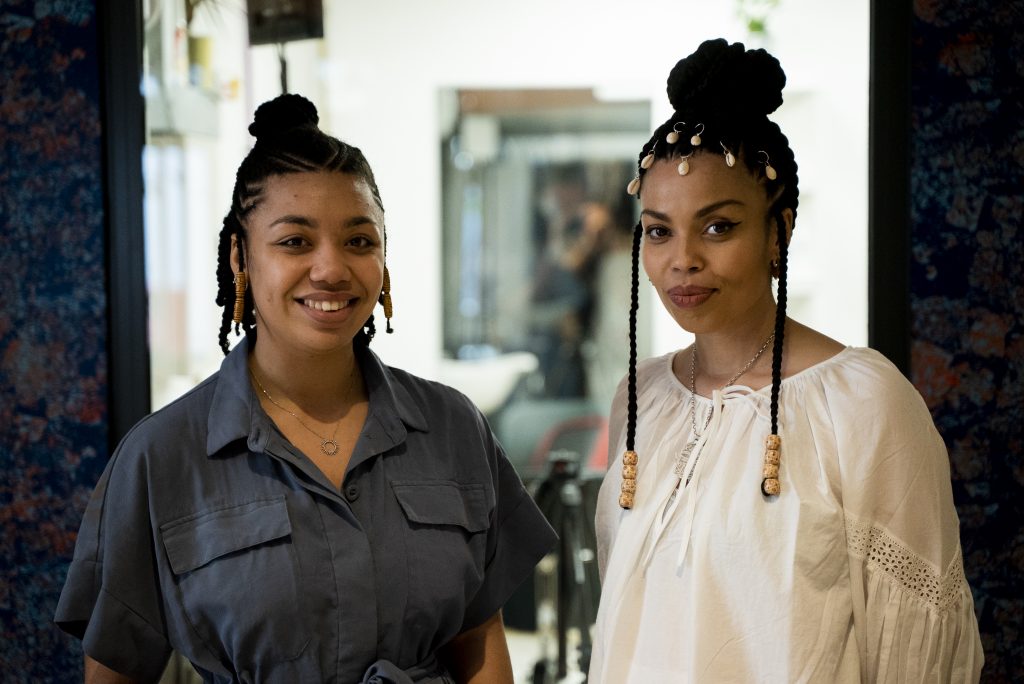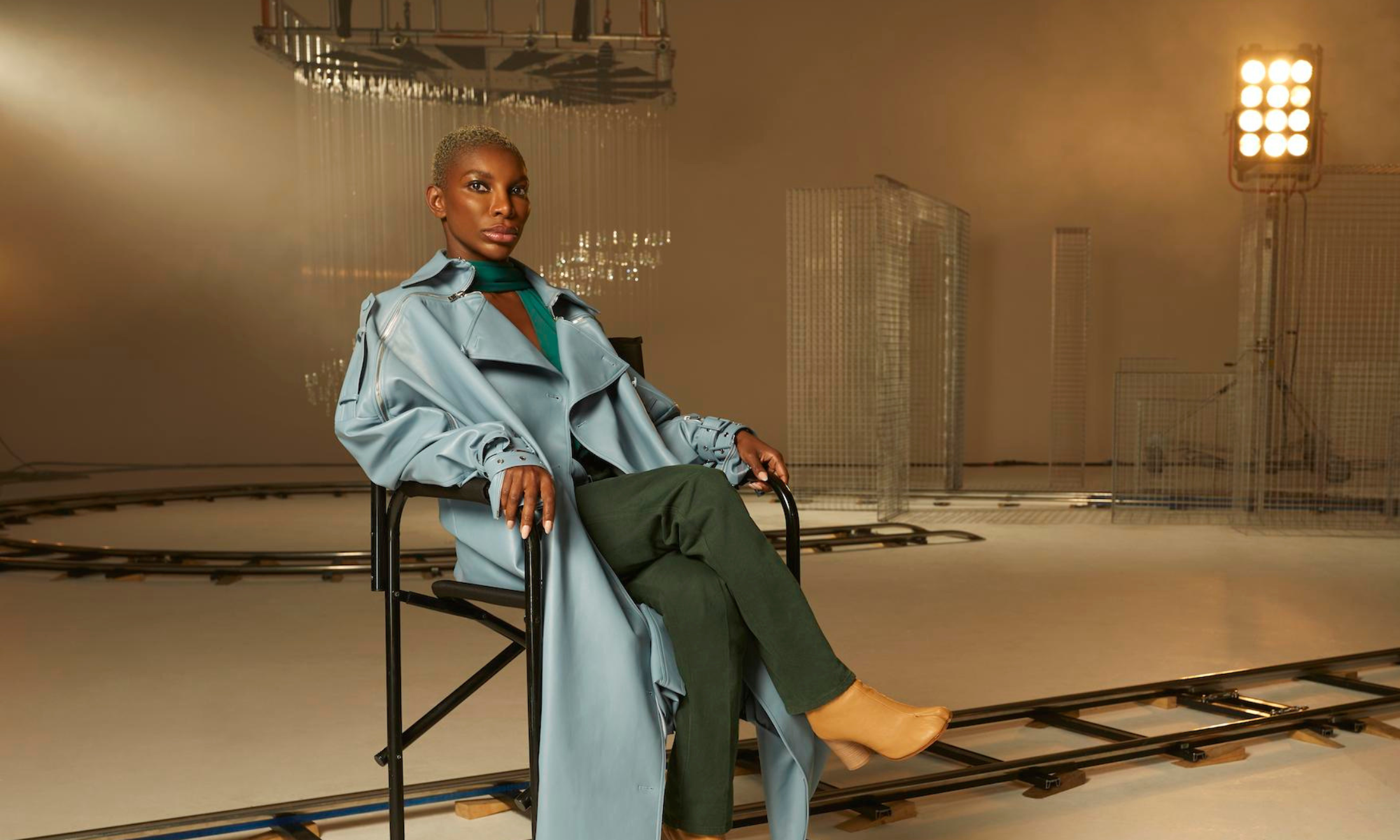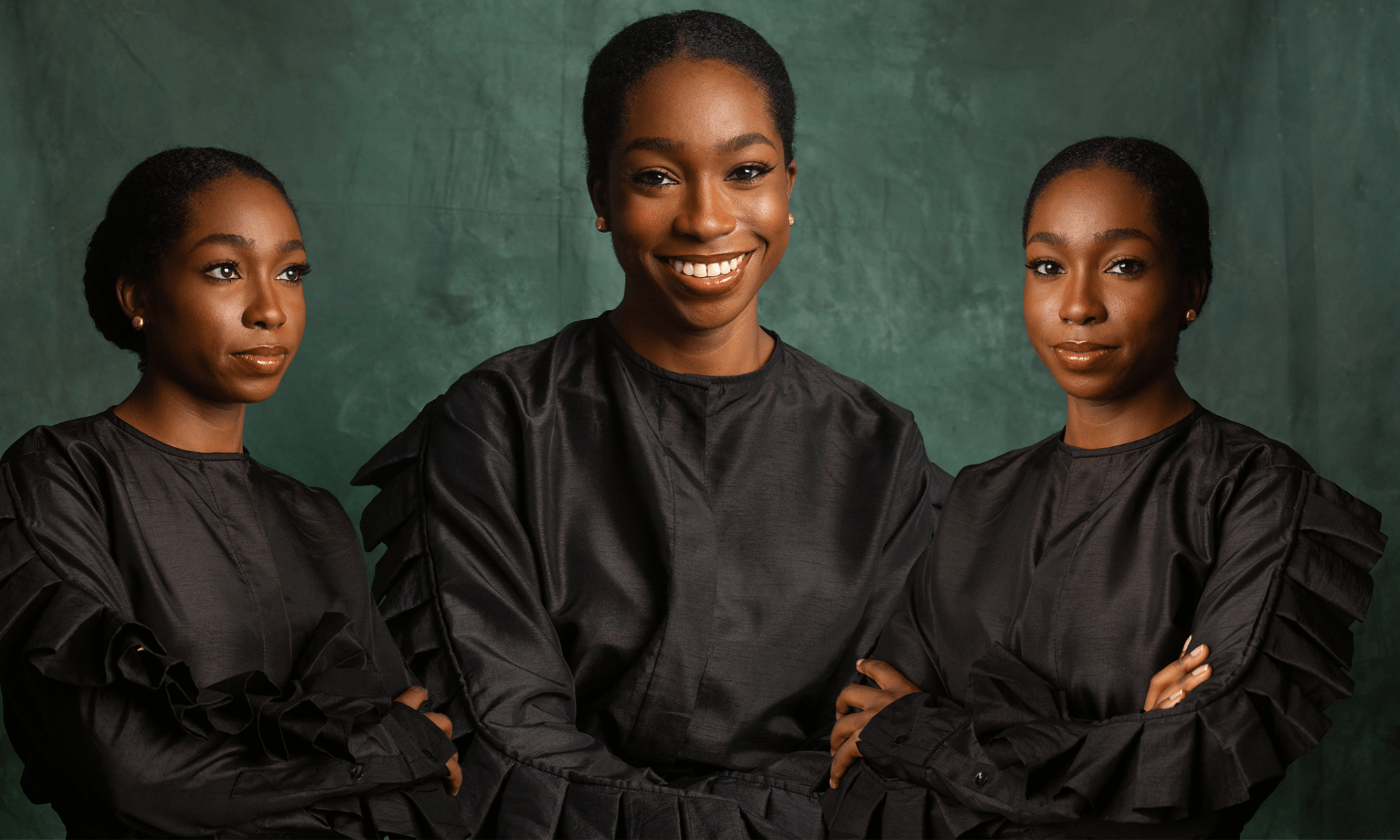
We had our hair braided with Emma Dabiri to talk about her new book ‘Don’t Touch My Hair’
Charlie Brinkhurst Cuff
04 May 2019
Photography by Adrian Cecil
Emma Dabiri has her neck twisted around uncomfortably so she can look me in the eyes. Behind her, Augusta Sesay, an expert Sierra Leonean hair braider, finishes binding up the final ends of a canerow on the back of her head.
We’re sitting side-by-side in Peckham Palms, the UK’s first purpose-built centre for afro hair and beauty start-ups, both getting our hair done in celebration of Emma’s new book Don’t Touch My Hair (DTMH). While Emma’s stylist is fashioning her a beautiful braided updo, Ebuni Ajiduah, a trichologist and natural hairstylist, is working a decorative braided twist-out into my curls.
Emma is both flippant and precise with her instructions. “I just saw the cowrie shells and I was like, ‘Oh, I want that now’,” she explains about the style she’s chosen. “But not too tight, because I worry about my poor edges.” She’s not afraid to say when the braider is slightly tugging at her head or to question the products used on her ‘fro. Later, when the stylist squirts a puff of hair mousse into her hand and lays it directly onto her freshly-did braids, she asks about the ingredients.
The broadcaster, academic, and former commercial model has had a relatably difficult journey with her hair – but it is through this medium that she has channelled a rigorous passion for knowledge that encompasses hair in more ways than you might have conceived. This book could have been a rumination on her hair journey, neatly linked to Solange’s song. Instead, Emma goes far beyond this. She uses snappy dialogue to develop new theories around black hair and relocate it away from Western discourse – which is, as she notes, thin on the ground when it comes to black history anyway.
From Emma’s book I learnt so much: about the complexity and symbolism of ancient black hairstyles like irun didi (Yoruba for cornrowing), about the ways in which black women like Annie Turnbo Malone were able to utilise haircare for their financial liberation in the early 20th century and about the multifaceted ways in which our hair has been a site for reflection, resistance, rebellion and remonstration. Her stories, though varied and well-researched, are often told through the empathy-inducing prism of her own experiences, even as they look backwards and forwards away from our time.
“I think it’s been a work that’s been a lifelong process, in a way,” says Emma as we first sit down and the hairdressers begin gently combing out our hair. In person, she is articulate and aims to be exacting with her dialogue – pausing and reframing sentences where necessary but almost always speaking with a smile. “I just really struggled with my hair, from a young age. I always thought about it a lot. Growing up I desperately wanted it to look anything other than the way it did.”
Much like my own, Emma’s hair is “coily” rather than loosely “curly”. It grows up and out rather than down, and (although as pointed out by my hairdresser Ebuni we should stop using the hair type charts as most people have multiple textures on their heads) Emma’s hair sits around a “4b” texture. The first splash in the book comes from her well-argued proclamation that our racialisation as black is as bound up in our coiled hair as in our colouring and that we live in a world where hair “texturism”, the idea that certain types of natural hair patterns are more desirable or beautiful than others, is prevalent.
“I am very aware of my complexion. I have written about it and colourism extensively. I always write from my own position and am always explicit about what that is”
Emma Dabiri
In the book, Emma writes that “being light-skinned mediates my experience of blackness, placing me highly within a distasteful ranking of value and worth, yet I also have tightly coiled Afro hair, for which my status, alas, tumbles several notches”. While acknowledging that hair is easier to disguise than complexion, the point still stands: colourism, which speaks to prejudice or discrimination against individuals with a dark skin tone, is in some ways an inadequate descriptor to capture the numerous levels of racialisation – and prejudice because of that racialisation – that black people can experience. Our hair has been used and continues to be used to dehumanise us.
“It’s not to say that favouritism because of proximity to whiteness didn’t exist before [Alice Walker coined it in 1982], but it just wasn’t called colourism. So there was more scope for there to be an awareness that was inclusive of skin shade, but also of hair, features and other things,” she explains. In the Dominican Republic, Emma notes, different terms exist that recognise the role that hair texture and phenotype play in this proximity. A jabao is someone who is light-skinned but with coily hair, while a trigueno is dark-skinned but with looser curls. Her sources suggest that triguenos are generally viewed more favourably.
Even so, in the UK light-skinned black people are still sometimes seen as more “palatable” faces of blackness. And as a caveat, Emma addresses her own privilege at some length within the book. “Intersectionality informs everything I do,” she tells me over email when questioned about it explicitly. “I am very aware of my complexion. I have written about it and colourism extensively. I always write from my own position and am always explicit about what that is. We also need to have a diversity of black voices. It would be a problem if it was only light-skinned people who were writing books, but what’s so exciting about now is [that] we are seeing the diversity of black voices in publishing.”
Nevertheless, with Emma, I sense a shared frustration around the conceptualisation of mixed race black identity. We are often boxed into something which is near-meaningless in its unspecificity and uncomfortable in it that it doesn’t recognise the fact that many mixed race black people are racialised simply as black in very white environments – and even more likely to be so if colouring, hair type and features conform to a certain aesthetic.
A child in 1980s Dublin, born to a white Trinidadian Irish mother and black Irish Nigerian father, she was precocious – making a “spiffy little anti-slavery pamphlet” age eight instead of attending Holy Communion. She has felt a strong black consciousness for a long time. In a Tumblr article from 2013, she writes that she rejects “a racist hierarchy of value and worth and refuse to position myself as separate from other black people in a bid to try and position myself that little bit closer to whiteness”. In a more recent tweet from 2017, she says that she identifies “as Black and Irish rather than as ‘mixed-race’. Like I always say ain’t no such thing as ‘half white’. Whiteness don’t work like that boo. You’re white or you’re not.”
In Ireland, Emma didn’t have much choice in how she was perceived. “I always saw myself as being very isolated. I was black and I was Irish, but there was no space for those two things to coexist together. And it wasn’t an identity I could ever share with other people,” she says. It wasn’t until later in life that Emma learnt of an older community of mixed race Irish people who were mistreated on a systemic level.
“It’s very different to be mixed race and be in a black environment,” she goes on. “But for mixed race people in white environments, there’s often nobody else of colour even in their family. And their friendship groups as well. So then they’re only one. Even though there’s lots of horrible stuff and there’s lots of racism, there’s also this kind of ‘special’ status.” Bursting into laughter, she references a Key & Peele sketch where the two men face off against each other, battling to become the singular black member of an all-white acapella group. “This is my seven white boys,” Peele says to Key.
Emma moved to London towards the end of the 90s, in her late teens. It wasn’t the path she had pictured for herself; having been accepted into an all-black college in Atlanta, but knocked back by international student fees, which her family could not afford. Even so, as she writes tongue-in-cheek in the book, she happily began to study at SOAS university with two intentions: “1. Date lots of cute black boys (had to make up for those lost years in Ireland, didn’t I) and 2. Get my hair properly straightened.” She explains: “[When I got to London], I actually managed to achieve the hair I had wanted my whole life, which was basically long, straightened hair. I used to wear tracks in it as well so it was really long and full and the hair of my dreams, finally.”
But after stints in Japan and Ghana working in development, she started a PhD back in London and came to realise that she could no longer reconcile her relaxed hair with her beliefs and politics. It had to go. “I didn’t even know what my hair texture was like. I thought, ‘I need to stop relaxing my hair’,” she says. When Emma became pregnant with her son she finally chopped it all off, having been growing out her relaxer for a year. “I didn’t want to do it though. It’s something I felt compelled to do. I felt like it was a sacrifice. And I still didn’t think there was any way I could be considered or perceived as attractive. I thought it was very ugly hair, but I thought I had to embrace it and make this sacrifice for the cause.”
Luckily, it was through the process of cutting it off, learning to understand its texture and experimenting with different natural styles that she was able to recreate her relationship with her hair. This came with unexpected blessings. “For 15 years if I touched it, my scalp was painful, but I never related that to the relaxer, I didn’t really think about it. But when I stopped relaxing it stopped hurting.” By 2016, she was confident enough to appear in a Guardian video sporting an Afro and explaining that “many of us now proudly showcase our natural coils, kinks and curls”.
But while she tries not to straighten her own hair too often, Emma isn’t diametrically opposed to the idea of black people straightening their hair in general. Black women have enough impositions on what they should and shouldn’t do with their bodies. Today, at the salon, her hair has been blown straight before the braiding begins. This is something she says she does every six months or so. “There’s an argument I make in the book where I say that straightening is quite aesthetically African, because in the cultures that I look at, there’s a strong tradition of complete transformation of your hair. You’ll transform your hair to suit the new environment that you’re in,” she explains. The Afro, meanwhile, a style which still sometimes makes Emma feel self-conscious, is something that you might rarely see a West African person sporting – some form of manipulation is far more common.
Naturally, a large part of the book dwells on beauty and desirability –though it is dealt with in a subversive way. “I write about being young and not being perceived as beautiful at all and then that shifting at a different point in my life and suddenly being in a space where people were like, ‘oh, you are like a good looking person’,” Emma says. “I couldn’t really get my head around that. I said, ‘that’s absolute bollocks’, basically.”
To me, Emma’s beauty is obvious in both her looks and the story she embodies. But I don’t doubt that the environment she grew up in didn’t always make her feel so in a comfortable way. Even as recently as 2018, a grimly racist piece published by The Irish Independent had a male writer frothing at the mouth when describing her: “In this most genteel of settings, Emma’s hair is an event, a happening, a lustrously-beautiful nimbus that frames her fine features. Curiosity and generations of cultural racism seem to spur the urge to pet it, stroke it. I heroically resist, but others are not so strong.” Gross.
She is ultimately someone who self-describes as having had a “difficult relationship” with her looks.
“When I got to a certain age, I stopped being considered ugly but it was like, ‘you are lucky you are pretty, it kinda compensates for being black’. That didn’t make me feel very confident. I was in fact deeply insecure,” she says. She developed severe food issues after an incident in Dublin. “I had just come back from Atlanta, where I had gained weight… I went out a couple of nights later and a guy pushed past me and was like, ‘I cant get past this fat nigger’. The shame I felt, all my friends heard as well (they didn’t say anything to him of course). I was like to myself I can’t change the ‘n’ word but no-ones gonna call me fat again!” she expands over email.
“When I got to a certain age, I stopped being considered ugly but it was like, ‘you are lucky you are pretty, it kinda compensates for being black’. That didn’t make me feel very confident”
Emma Dabiri
She recounts how she “would spend, I don’t know, two hours, three hours [getting ready] and wear makeup before even if I wasn’t leaving the house? As I got older, I came to realise that this really unhealthy relationship that I had with beauty and appearance was something that I had to deal with. I had to divest how much I invested in looks.”
It is from this standpoint that she challenges the widely lauded Black is Beautiful movement of the 1960s – stating it “did nothing to displace the oppressive notion that black women had a special duty to their race to be beautiful” and adds that it offered up another very narrow beauty standard for black women. She notes Toni Morrison’s argument that “beauty is too fragile” to be used to fight for equality. In its place, she gives the reader “world-sense”, a term used by Nigerian feminist scholar Oyèrónkẹ́ Oyèwùmí to describe cultures that do not “place emphasis on the visual” and something that, as a person who has come to understand that beauty regimes are an “oppressive construct”, she found “fascinating and liberatory”.
Emma is of Yoruba heritage and is a teaching fellow in the Africa department at SOAS – quite naturally, beauty is far from the only place in the book that African concepts blossom and bloom. DTMH is laced with them. One of the most significant is something I think about from the first moment we’re together on this cool, early spring day: time. Both Emma and I are slightly late to the hairstyling appointment and the hair session with Augusta and Ebuni stretches on for hours but goes by quickly thanks to the interview. “We jest about black people time, but African concepts of time deserve further consideration,” she writes in the book. “It is only as recently as the colonialism imposed in the late nineteenth century that the continent was brought under the tyranny of the 24-hour clock”.
Because of the time strictures imposed upon us, Emma wants black people to stop viewing their hair as being “time-consuming”. She writes: “The time it takes to do Afro hair is, quite frankly, the time that is required to do it… Our hair continues to be a space in which the fault lines between an imposed European system and black bodies’ resistance to that system are exposed.” As she explains to me further, Africans “weren’t capitalists, they weren’t just thinking about maximising profit. So they had time to do their hair. They had time to engage in rituals and different cultural pursuits”.
“Today, you often have individual actors whose primary concern is personal success, using the language of black liberation and feminism, but they’re not really for the cause”
Emma Dabiri
In general, Emma’s work isn’t afraid to highlight how popular cultural commentators should do better when it comes to knowing their history and involving radical anti-capitalist theory. In the book, this means highlighting an incident in the 90s where Angela Davis called out Vibe magazine for publishing a fashion editorial titled ‘Free Angela’ which had an actress reproducing her aesthetic. She believed it was in service of consumerism and, according to DTMH, “incongruous with everything she stood for”.
“Today, you just often have individual actors whose primary concern is self promotion and personal success, using the language of black liberation, of feminism, but they’re not really for [the cause],” Emma ruminates. “It’s just become highly individualistic and about personal success rather than about any kind of collective, transformative action. I think that’s really sad.”
As we wrap up, Emma’s hairstyle is somewhat unexpected, but she’s pleased with it. Seeing (and sensing) Emma in her white dress, hair piled up, cowrie shells dripping over her face, hairstylist Ebuni says she looks “ethereal”. Ebuni’s own hair is a perfect halo of blue curls – testament to the current range of diversity you see in hairstyles within the black community and especially in areas like Peckham, otherwise known as “Little Lagos”.
In a perfect symmetry of events, today is the day that the first, finalised printed copies of DTMH have arrived. It has a coral cover, decorated with columns of afro curls. Although nervous when she first picks up a copy at the beginning of the interview, and holding herself back from looking for mistakes (of which her publisher assures her there are none), by the end of the session she is happily signing books for Ebuni, Augusta and the rest of the Peckham Palms team, cowrie shells tinkling as she bends forwards.
But what’s next for Emma – someone, from the outside at least, who seems to be perpetually busy? Is she going to start reclaiming some of her time, like her hero, black congresswoman Maxine Waters? “I aspire to be reclaiming more of my time and it will help a great deal now that I’ve finished writing this book, but now I have a really tiny window left to finish my PhD. I don’t valorise the idea of ‘the grind’ or constant hustling… I would much rather slow down and just have time to do my hair.”









